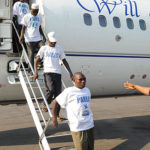A search team on Thursday recovered the cockpit voice recorder from the EgyptAir plane that crashed into the Mediterranean last month in a major step towards establishing the cause of the tragedy.
The device was found broken into pieces but the salvage experts managed to retrieve the recorder’s crucial memory unit, Egypt’s civil aviation authority said.
Officials are preparing to transfer the recorder from a search vessel in the Mediterranean to Egypt for analysis, a statement said.
The cockpit voice recorder keeps track of conversations and other sounds in the pilots’ cabin.
The breakthrough came hours after a deep-sea robot located pieces of the main body of the plane at the bottom of the Mediterranean.
Airbus said the flight recorders held the key to unlocking the mystery of why the plane went down with 66 people on board en route from Paris to Cairo nearly a month ago.
“The first photos of the wreckage do not allow to establish any scenario of the accident,” an Airbus statement said.
“Only the black boxes could contribute to a full understanding of the chain of events which led to this tragic accident.”
Investigators have said it is too soon to determine what caused flight MS804 from Paris to Cairo to crash on May 19, although a terror attack has not been ruled out.
The search vessel John Lethbridge, equipped with an underwater robot, arrived in Egypt last week to begin searching an area around 290 kilometres (180 miles) north of the Egyptian coast.
The robot discovered pieces of the fuselage at “several sites”, the Egyptian board of inquiry said late Wednesday.
A source close to the investigation told AFP that the robot, operated by Mauritius-based Deep Ocean Search, had found “small fragments” of the plane.
Some wreckage had already been pulled out of the Mediterranean by search teams last month, along with belongings of passengers.
– Limited battery life –
Search teams are still looking for the flight data recorder, which gathers information about the speed, altitude and direction of the plane.
Search teams are still looking for the flight data recorder, which gathers information about the speed, altitude and direction of the plane.
The area where the plane crashed is believed to be about 3,000 metres (10,000 feet) deep and the black boxes should have had enough battery power to emit signals for four to five weeks.
France’s aviation safety agency has said the EgyptAir plane transmitted automated messages indicating smoke in the cabin and a fault in the flight control unit minutes before disappearing from radar screens.
On Monday, Egyptian investigators confirmed that the aircraft had made a 90-degree left turn followed by a 360-degree turn to the right before hitting the sea.
Investigators were able to narrow down the search site thanks to an emergency signal sent via satellite by the plane’s locator transmitter when it hit the Mediterranean.
The passengers on the plane were 30 Egyptians, 15 French citizens, two Iraqis, two Canadians, and citizens from Algeria, Belgium, Britain, Chad, Portugal, Saudi Arabia and Sudan. They included a boy and two babies.
Seven crew and three security personnel were also on board.
The crash came after the bombing of a Russian airliner over Egypt’s restive Sinai Peninsula last October that killed all 224 people on board.
The Islamic State group claimed responsibility for that attack within hours, but there has been no such claim linked to the EgyptAir crash.
IS has been waging a deadly insurgency against Egyptian security forces and has claimed attacks in both France and Egypt.
In October, foreign governments issued travel warnings for Egypt and demanded a review of security at its airports after IS said it downed the Russian airliner over the Sinai with a bomb concealed in a soda can that had been smuggled onboard.
The main locations of wreckage from the EgyptAir jet that crashed in the eastern Mediterranean last month have been identified, the Egyptian-led investigation committee said.
The Deep Ocean Search-owned vessel, the John Lethbridge, contracted by the Egyptian government, is working against the clock to locate the flight recorders that will help explain why EgyptAir MS804 crashed on May 19, killing all 66 people on board.
Signals from the data recorders needed to locate them down on the seabed are expected to expire on June 24.
The John Lethbridge has provided the first images of wreckage to investigators. A search team on board along with investigators will now draw a map of the wreckage’s distribution spots, the committee said in a statement.
Previously collected debris will also be handed over to the investigation committee after “standard procedures” are completed by prosecutors who are currently holding it for forensic evidence, the statement added.
To recover the recorders, about 3,000 metres (10,000 feet) below the sea surface, investigators will need to pinpoint the signals to within a few metres and establish whether the pingers are still connected to the recorders.
(Reuters)






